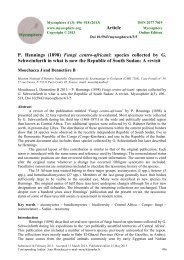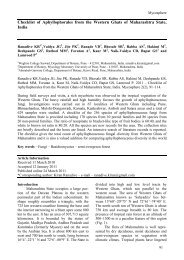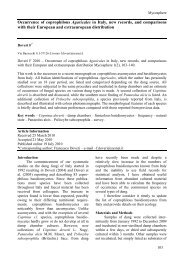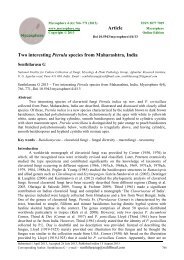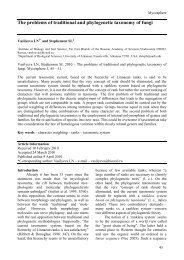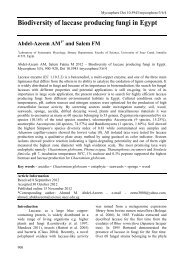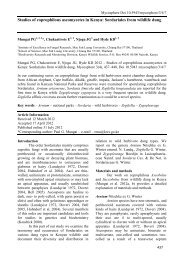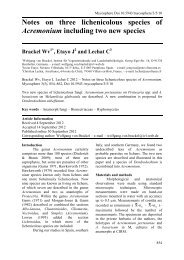A contribution to the ITS-LSU phylogeny of the genus Leucopaxillus ...
A contribution to the ITS-LSU phylogeny of the genus Leucopaxillus ...
A contribution to the ITS-LSU phylogeny of the genus Leucopaxillus ...
You also want an ePaper? Increase the reach of your titles
YUMPU automatically turns print PDFs into web optimized ePapers that Google loves.
Mycosphere Doi 10.5943/mycosphere/3/1/10A <strong>contribution</strong> <strong>to</strong> <strong>the</strong> <strong>ITS</strong>-<strong>LSU</strong> <strong>phylogeny</strong> <strong>of</strong> <strong>the</strong> <strong>genus</strong> <strong>Leucopaxillus</strong>(/tricholoma<strong>to</strong>id clade, Agaricales), with three new genera and notes onPorpolomaVizzini A 1* , Ercole E 1 and Contu M 21 Dipartimen<strong>to</strong> di Scienze della Vita e Biologia dei Sistemi, Università degli Studi di Torino, Viale P.A. Mattioli 25,10125-Torino, Italy2 Via Marmilla 12, 0702- Olbia (OT), ItalyVizzini A, Ercole E, Contu M 2012 – A <strong>contribution</strong> <strong>to</strong> <strong>the</strong> <strong>ITS</strong>-<strong>LSU</strong> <strong>phylogeny</strong> <strong>of</strong> <strong>the</strong> <strong>genus</strong><strong>Leucopaxillus</strong> (/tricholoma<strong>to</strong>id clade, Agaricales), with three new genera and notes on Porpoloma.Mycosphere 3(1), 79–90, Doi 10.5943/mycosphere/3/1/10Phylogenetic analyses based on <strong>ITS</strong>-<strong>LSU</strong> rDNA sequences dataset indicate that <strong>Leucopaxillus</strong>, ascurrently defined, is a highly polyphyletic <strong>genus</strong>. The new genera Giacomia, Notholepista andPseudocli<strong>to</strong>pilus are introduced <strong>to</strong> accommodate <strong>Leucopaxillus</strong> mirabilis, L. subzonalis and L.rhodoleucus, respectively. <strong>Leucopaxillus</strong> subg. Aspropaxillus also seems <strong>to</strong> represent an independentevolutionary line in <strong>the</strong> /tricholoma<strong>to</strong>id clade, for which we suggest resurrecting <strong>the</strong> <strong>genus</strong>Aspropaxillus. Fur<strong>the</strong>rmore, <strong>the</strong> morphologically allied <strong>genus</strong> Porpoloma is also polyphyletic.Key words – Agaricomycetes – new combinations – <strong>ITS</strong>-<strong>LSU</strong> sequences – taxonomyArticle InformationReceived 1 February 2012Accepted 7 February 2012Published online 29 February 2012*Corresponding author: Alfredo Vizzini – e-mail – alfredo.vizzini@uni<strong>to</strong>.itIntroductionThe basidiomycete <strong>genus</strong> <strong>Leucopaxillus</strong>Boursier, typified by L. paradoxus (Costantin &L.M. Dufour) Boursier and traditionally placed,<strong>to</strong>ge<strong>the</strong>r with Melanoleuca Pat., in <strong>the</strong> subtribusLeucopaxillineae Singer (tribus LeucopaxillaeSinger, family Tricholomataceae R. Heim exPouzar <strong>of</strong> <strong>the</strong> Agaricales Underw., Singer1986), consists <strong>of</strong> cosmopolitan species withusually terrestrial basidiomata. It is characterizedby <strong>the</strong> following: cli<strong>to</strong>cyboid <strong>to</strong> tricholoma<strong>to</strong>idhabit; convex <strong>to</strong> slightly depressed pilei;adnate <strong>to</strong> decurrent lamellae easily separablefrom <strong>the</strong> pileus context; veils usually absent;white <strong>to</strong> pale yellowish spore print; cutis <strong>to</strong>trichoderm pileipellis; hyaline, smooth <strong>to</strong> verruculosespores, smooth spores weakly amyloid(subg. Aspropaxillus (Kühner & Maire) Bon =sect. Aspropaxillus), verrucose spores withstrongly amyloid ornamentations and without awell differentiated plage (subg. <strong>Leucopaxillus</strong> =sect. <strong>Leucopaxillus</strong>); cheilocystidia absent orhyphoid (not well developed); presence <strong>of</strong>clamp connections (Singer & Smith 1943,Pegler & Young 1973, Singer 1986, Bon 1991,Gulden 1992, Noordeloos 1984, 1995,Consiglio & Contu 2000, Horak 2005,Christensen 2008, Watling & Turnbull 2008,Vizzini 2009). Regarding its trophic status,Bryan & Zak (1961) reported on a ec<strong>to</strong>mycorrhizalsyn<strong>the</strong>sis between <strong>Leucopaxillus</strong>albissimus var. piceinus and Pinus sp. but witha poorly developed mycoclena and Hartig net.This taxon probably represents a Tricholomasp. (Ma<strong>the</strong>ny et al. 2006). Stable iso<strong>to</strong>pes(Kohzu et al. 1999, Hart et al. 2006) andsyn<strong>the</strong>sis experiments (Yamada et al. 2001)suggest that <strong>Leucopaxillus</strong> species are nonec<strong>to</strong>mycorrhizalbut saprotrophic in forest andgrassland (Tedersoo et al. 2010). Species <strong>of</strong>79
<strong>Leucopaxillus</strong> subg. Aspropaxillus (L. candidus(Bres.) Singer, L. giganteus (Sowerby) Singer,L. lepis<strong>to</strong>ides (Maire) Singer) may produce verylarge fairy rings; Kaiser (1998) studied <strong>the</strong>relationships between L. giganteus, micr<strong>of</strong>ungiand herbaceous plants. <strong>Leucopaxillus</strong> speciesturned out <strong>to</strong> be easy <strong>to</strong> cultivate in vitro:mycelia <strong>of</strong> some species are characterized byforming chlamydoconidia (rhexolytically secedingconidia) in pure culture (Pantidou et al.1983, Buchalo 1988, Ingaramo 2002).Melanoleuca, a morphologically allied<strong>genus</strong>, differs from <strong>Leucopaxillus</strong> mainly inlacking clamp connections, by spores with awell differentiated plage area, and usuallyhaving well-developed hymenial thick-walledcystidia (Singer 1986, Bon 1978, 1991,Boekhout 1999). But, according <strong>to</strong> recentmolecular analyses (Moncalvo et al. 2000,2002, Ma<strong>the</strong>ny et al. 2006, Vizzini et al.2011a), Melanoleuca and <strong>Leucopaxillus</strong> are notphylogenetically closely related: Melanoleucaspecies cluster within <strong>the</strong> Pluteoid clade(Pluteaceae Kotl. & Pouzar partim + AmanitaceaeR. Heim ex Pouzar + LymnoperdaceaeG.A. Escobar + Macrocystidiaceae Kühner +Pleurotaceae Kühner) (Moncalvo et al. 2002,Bodensteiner et al. 2004, Binder et al. 2006,Ma<strong>the</strong>ny et al. 2006, Vizzini et al. 2011a) sister<strong>to</strong> a monophyletic group formed by Pluteus Fr.species and Volvopluteus Vizzini, Contu &Jus<strong>to</strong> (Jus<strong>to</strong> et al. 2011), whereas <strong>Leucopaxillus</strong>belongs <strong>to</strong> <strong>the</strong> /tricholoma<strong>to</strong>id clade, close <strong>to</strong>Porpoloma sp. + Tricholoma (Fr.) Staude(Moncalvo et al. 2002) or sister <strong>to</strong> Tricholoma(Ma<strong>the</strong>ny et al. 2006). <strong>Leucopaxillus</strong>, <strong>to</strong>ge<strong>the</strong>rwith Cli<strong>to</strong>cybe (Fr.) Staude, Collybia (Fr.)Staude, Lepista (Fr.) W.G. Sm., and Tricholoma(Fr.) Staude, forms <strong>the</strong> family Tricholomataceaes.s. (Moncalvo et al. 2002, Ma<strong>the</strong>ny etal. 2006). Therefore, morphological similaritiesbetween <strong>Leucopaxillus</strong> and Melanoleuca aredue <strong>to</strong> evolutionary convergence.Porpoloma Singer, typified by P.sejunctum Singer, differs in having a cleartricholoma<strong>to</strong>id habit, non-decurrent lamellaethat are not separable from <strong>the</strong> pileux context,and always smooth amyloid spores(Rai<strong>the</strong>lhuber 1980, Singer 1986, Bon 1991).The unique Porpoloma sequence (Porpolomasp. AF261395) used in a phylogenetic analysisMycosphere Doi 10.5943/mycosphere/3/1/10(Moncalvo et al. 2002), clustered sister <strong>to</strong><strong>Leucopaxillus</strong>, forming with Tricholoma and<strong>Leucopaxillus</strong> <strong>the</strong> /tricholoma<strong>to</strong>id clade.The <strong>genus</strong> <strong>Leucopaxillus</strong> is not yet wellcovered by DNA studies and only a few specieshave been sequenced. The present study, basedon a wider <strong>ITS</strong>-<strong>LSU</strong> sequence dataset,sequences retrieved both from public databases(GenBank, www.ncbi.nlm.nih.gov/genbank/and UNITE, unite.ut.ee/) and from newlysequenced collections, is <strong>the</strong> first <strong>to</strong> examinethis <strong>genus</strong> extensively. The aim was <strong>to</strong> checkwhe<strong>the</strong>r <strong>Leucopaxillus</strong> is monophyletic astraditionally circumscribed.MethodsMorphologyAll <strong>Leucopaxillus</strong> collections wereidentified or redetermined using specificmonographs (Singer & Smith 1943, Bon 1991,Consiglio & Contu 2000). Watling & Turnbull(1983), Horak (2005), and Christensen (2008)were also consulted. When not identifiable,collections are cited in Table 1 and Figs. 1–2 as<strong>Leucopaxillus</strong> sp. Author citations follow <strong>the</strong>Index Fungorum-Authors <strong>of</strong> Fungal Names(www.indexfungorum.org/authors<strong>of</strong>fungalnames.htm) and <strong>the</strong> names <strong>of</strong> new taxa are depositedin MycoBank (www.mycobank.org/Default-Page.aspx). Herbarium acronyms follow Thiers(2011) except for “GC” that refers <strong>to</strong> <strong>the</strong>personal herbarium <strong>of</strong> Giovanni Consiglio.DNA extraction, PCR amplification, andDNA sequencingGenomic DNA was isolated from 1 mg<strong>of</strong> herbarium specimens (Table 1) by using <strong>the</strong>DNeasy Plant Mini Kit (Qiagen, Milan, Italy)following <strong>the</strong> manufacturer’s instructions. Universalprimers <strong>ITS</strong>1F/<strong>ITS</strong>4 were used for <strong>the</strong><strong>ITS</strong> region amplification (White et al. 1990,Gardes & Bruns 1993) and primers LR0R/LR7(Vilgalys & Hester 1990, Vilgalys lab,unpublished,www.botany.duke.edu/fungi/mycolab) for <strong>the</strong> <strong>LSU</strong> rDNA amplification.Amplification reactions were performed inPE9700 <strong>the</strong>rmal cycler (Perkin-Elmer, AppliedBiosystems) in a 25 µl reaction mixture using<strong>the</strong> following final concentrations or <strong>to</strong>talamounts: 5 ng DNA, 1× PCR buffer (20 mM80
Mycosphere Doi 10.5943/mycosphere/3/1/10Table 1 <strong>Leucopaxillus</strong> and Porpoloma new sequenced collection used in this study for <strong>the</strong> molecularanalyses.Species GenBank acc. Numbers Source, country<strong>ITS</strong> <strong>LSU</strong><strong>Leucopaxillus</strong> alboalutaceus (F.H. Møller) F.H. Møller JQ639147 — GC 97076, Italy<strong>Leucopaxillus</strong> cerealis (Lasch) Singer JQ639148 JQ639149 TO AVL20112, Italy<strong>Leucopaxillus</strong> giganteus (Sowerby) Singer JQ639150 — GC 94133, Italy<strong>Leucopaxillus</strong> giganteus JQ639151 JQ639152 GC 98046, Italy<strong>Leucopaxillus</strong> mirabilis (Bres.) Konrad & Maubl. JQ639153 JQ639154 GC 94141, Italy<strong>Leucopaxillus</strong> mirabilis var. nigrescens Fontenla & Para JQ639155 — GC 07186, Italy<strong>Leucopaxillus</strong> monticola (Singer & A.H. Sm.) Bon JQ639156 — TO AVL20111, France<strong>Leucopaxillus</strong> paradoxus (Costantin & L.M. Dufour) Boursier JQ639157 JQ639158 TO AVL20113, Italy<strong>Leucopaxillus</strong> sp. 1 JQ639159 — TO AVL20114, Italy<strong>Leucopaxillus</strong> sp. 2 JQ639160 JQ639161 TO AVL20115, ItalyPorpoloma macrocephalum (Schulzer) Bon JQ639162 JQ639163 GC 96016, ItalyPorpoloma metapodium (Fr.) Singer JQ639164 — TO AVL20116, FranceTris/HCl pH 8.4, 50 mM KCl), 1 µM <strong>of</strong> eachprimer, 2.5 mM MgCl 2 , 0.25 mM <strong>of</strong> eachdNTP, 0.5 unit <strong>of</strong> Taq polymerase (Promega).The PCR program was as follows: 3 min at95°C for 1 cycle; 30 s at 94°C, 45 s at 50°C, 2min at 72°C for 35 cycles, 10 min at 72°C for 1cycle. PCR products were resolved on a 1.0%agarose gel and visualized by staining wi<strong>the</strong>thidium bromide. PCR products were purifiedand sequenced by DiNAMYCODE srl (Turin,Italy). Sequence assembly and editing wereperformed using Geneious v5.3 (Drummond etal. 2010). The sequences are deposited inGenBank under <strong>the</strong> accession numbers given inTable 1 and Figs. 1–2.Sequence alignment and phylogeneticanalysisSequences included in <strong>the</strong> phylogeneticanalyses were ei<strong>the</strong>r generated in this study(Table 1) or retrieved from GenBank andUNITE databases, according <strong>to</strong> recent studieson Agaricales (Moncalvo et al. 2002, Ma<strong>the</strong>nyet al. 2006, Vizzini 2011b).Two separate analyses <strong>of</strong> <strong>ITS</strong> and <strong>LSU</strong>sequences were carried out. Alignments weregenerated using MAFFT v6.814b (Ka<strong>to</strong>h et al.2002) with default conditions for gap openingsand gap extension penalties. Alignments wereslightly edited using MEGA 5.0 (Tamura et al.2011). Molecular-phylogenetic analyses wereperformed using <strong>the</strong> Maximum likelihood (ML)and Bayesian inference (BI) approaches. MLestimation was performed through RAxML(Stamatakis 2006) with 1000 bootstrapreplicates (Felsenstein 1985) using <strong>the</strong>GTRGAMMA algorithm <strong>to</strong> perform a treeinference and search for a good <strong>to</strong>pology.Support values from bootstrapping runs (MLB)were mapped on <strong>the</strong> globally best tree using <strong>the</strong>-f a option <strong>of</strong> RAxML and -x 12345 as arandom seed <strong>to</strong> invoke <strong>the</strong> novel rapidbootstrapping algorithm. BI <strong>of</strong> <strong>phylogeny</strong> usingMonte Carlo Markov Chains (MCMC) wascarried out with MrBayes (Huelsenbeck &Ronquist 2001). Four incrementally heatedsimultaneous MCMC were run over 10 000 000generations, under GTR+G model assumption.Trees were sampled every 1000 generationsresulting in an overall sampling <strong>of</strong> 10 001 trees.The ‘‘burn-in’’ value was evaluated usingTracer (Rambaut & Drummond 2007). The first20% <strong>of</strong> trees was discarded as ‘‘burn-in’’. For<strong>the</strong> remaining trees, a majority rule consensustree showing all compatible partitions wascomputed <strong>to</strong> obtain estimates for BayesianPosterior Probabilities (BPP). Branch lengthswere estimated as mean values over <strong>the</strong>sampled trees.Xeromphalina campanella (Hygrophoroidclade, GenBank accessions GU320006and GU320009) was used in both datasetsanalysis as outgroup taxon. Only MLB and BPPvalues over 50% and 0.75, respectively, arereported in <strong>the</strong> resulting trees (Figs. 1–2).Pairwise % identity values <strong>of</strong> <strong>ITS</strong> sequences81
Mycosphere Doi 10.5943/mycosphere/3/1/10Fig. 1 – Maximum likelihood phylogram obtained from <strong>the</strong> <strong>ITS</strong> sequence dataset <strong>of</strong> <strong>the</strong>/tricholoma<strong>to</strong>id clade. Xeromphalina campanella (Hygrophoroid clade) was used as outgroup.Support values (MLB, in bold and BPP) are given above branches. <strong>Leucopaxillus</strong> and Porpolomasequences are in bold. * refers <strong>to</strong> samples sequenced in this work and reported in Table 1. The barindicates number <strong>of</strong> substitutions per site.were calculated using MEGA 5.0 (Tamura et al.2011).ResultsMaximum likelihood and Bayesianinferences were performed on a <strong>to</strong>tal <strong>of</strong> 81sequences <strong>of</strong> <strong>the</strong> <strong>ITS</strong> dataset, including 69sequences available from GenBank and UNITEpublic databases. Final alignment length was916 bp. The <strong>LSU</strong> dataset consists <strong>of</strong> 60sequences, including 54 available fromGenBank and UNITE databases. Finalalignment length was 1614 bp. Topology <strong>of</strong>Maximum likelihood and Bayesian phylotreesis congruent.In <strong>the</strong> <strong>ITS</strong> phylogram (Fig. 1)<strong>Leucopaxillus</strong> paradoxus (<strong>the</strong> type species <strong>of</strong><strong>the</strong> <strong>genus</strong>) clusters <strong>to</strong>ge<strong>the</strong>r with L. monticola,L. cerealis, L. alboalutaceus, <strong>Leucopaxillus</strong> sp.1 and sp. 2 and “Tricholomataceae aff.Porpoloma” forming a monophyletic <strong>genus</strong><strong>Leucopaxillus</strong> s.s. The <strong>genus</strong> is sister <strong>to</strong>Porpoloma sp. EF421106 (DUKE-PR3995). L.giganteus, L. rhodoleucus, L. subzonalis, L.mirabilis and L. mirabilis var. nigrescens falloutside <strong>Leucopaxillus</strong> s.s. Porpoloma spinulosum,P. metapodium, Porpoloma sp.EF421106, “Tricholomataceae aff. Porpoloma”and P. macrocephalum do not form a coherentgroup. The four <strong>Leucopaxillus</strong> tricolor82
sequences from GenBank clearly do notrepresent a <strong>Leucopaxillus</strong> but a taxon very close<strong>to</strong> Lepista nebularis (pairwise % identity value99.4). The two Porpoloma macrocephalumsequences and <strong>the</strong> <strong>Leucopaxillus</strong> nauseodulcissequence showed a pairwise % identity value <strong>of</strong>99.0, and are conspecific.In <strong>the</strong> <strong>LSU</strong> phylogram (Fig. 2) L.paradoxus, L. cerealis, L. albissimus (Peck)Singer (= L. cerealis (Lasch) Singer, fideSinger 1986), L. gentianeus and <strong>Leucopaxillus</strong>sp. 2 form a monophyletic group (<strong>Leucopaxillus</strong>s.s.). <strong>Leucopaxillus</strong> s.s., <strong>to</strong>ge<strong>the</strong>r withPorpoloma AF261395 (JLPR3395), is sister <strong>to</strong>Tricholoma. L. mirabilis and L. giganteus areindependent from <strong>Leucopaxillus</strong>. PorpolomaAF261395 (JLPR3395) is not related <strong>to</strong>Porpoloma macrocephalum.DiscussionOur molecular analyses clearly show(Figs. 1–2) that <strong>Leucopaxillus</strong>, as currentlydefined, is polyphyletic. Species traditionallyascribed <strong>to</strong> this <strong>genus</strong> (Singer 1986, Bon 1991,Consiglio & Contu 2000, Christensen 2008) donot form a monophyletic assemblage and aredistributed over <strong>the</strong> /tricholoma<strong>to</strong>id clade.According <strong>to</strong> <strong>the</strong> <strong>LSU</strong> analysis (Fig. 2)<strong>Leucopaxillus</strong> s.s. and Porpoloma AF261395(JLPR3395) are sister <strong>to</strong> Tricholoma, inagreement with Moncalvo et al. (2002) and with<strong>the</strong> multilocus phylogenetic overview byMa<strong>the</strong>ny et al. (2006). The <strong>Leucopaxillus</strong>/Tricholomaconnections were alreadyhighlighted, even if only on morphologicalbases, by Kühner (1980). So it is evident that<strong>the</strong> “leucopaxilloid” facies (basidiomata with acli<strong>to</strong>cyboid <strong>to</strong> tricholoma<strong>to</strong>id habit, clampconnectionsand spores with amyloid ornamentations)have arisen many times in more or lessindependent lines <strong>of</strong> evolution. Within <strong>Leucopaxillus</strong>s.s., <strong>Leucopaxillus</strong> sp. 1 and <strong>Leucopaxillus</strong>sp. 2 are collections representative <strong>of</strong> ayet undescribed taxon characterized byclampless basidiomata and mainly bisporicbasidia. <strong>Leucopaxillus</strong> giganteus, L. mirabilis,L. subzonalis and L. rhodoleucus are notphylogenetically connected with <strong>Leucopaxillus</strong>s.s and are unrelated <strong>to</strong> each o<strong>the</strong>r (Figs. 1–2).They represent new genera in <strong>the</strong> /tricholoma<strong>to</strong>idclade.Mycosphere Doi 10.5943/mycosphere/3/1/10Resurrecting <strong>the</strong> <strong>genus</strong> Aspropaxillus<strong>Leucopaxillus</strong> giganteus is <strong>the</strong> typespecies <strong>of</strong> Aspropaxillus Kühner & Maire.Kühner & Maire (1934) established <strong>the</strong> <strong>genus</strong><strong>to</strong> accommodate <strong>the</strong> smooth-spored species,with a cli<strong>to</strong>cyboid habitus and a perisporiumcharacterized by a weak amyloid reaction.Singer & Smith (1943), in <strong>the</strong>ir monographictreatment <strong>of</strong> <strong>Leucopaxillus</strong>, maintained thisseparation but only at a sectional level. Bigelow(1982) considered it as a subsection <strong>of</strong> sectionCli<strong>to</strong>cybe within his heterogeneous definition <strong>of</strong>Cli<strong>to</strong>cybe (Fr.) Staude. Finally, Bon (1990,1991) accepted it as a distinct sub<strong>genus</strong> <strong>of</strong><strong>Leucopaxillus</strong>. According <strong>to</strong> both <strong>ITS</strong> and <strong>LSU</strong>analyses (Figs. 1–2), we suggest using <strong>the</strong><strong>genus</strong> Aspropaxillus for L. giganteus and alliedspecies. Therefore, we propose <strong>the</strong> followingnew combinations:Aspropaxillus Kühner & Maire, Bull. trimest.Soc. mycol. Fr. 50: 13, 1934. <strong>Leucopaxillus</strong> subgen. Aspropaxillus(Kühner & Maire) Bon, Docum. Mycol. 20(79):57, 1990.Type: Aspropaxillus giganteus(Sowerby) Kühner & MaireAspropaxillus septentrionalis (Singer & A.H.Sm.) Vizzini, comb. nov.MycoBank MB 564422 <strong>Leucopaxillus</strong> septentrionalis Singer& A.H. Sm. Mycologia 39: 726, 1948 [1947](basionym). Cli<strong>to</strong>cybe septentrionalis (Singer &A.H. Sm.) H.E. Bigelow, Canad. J. Bot. 37:772, 1959.Aspropaxillus sainii (Singer) Vizzini, comb.nov.MycoBank MB 564424 <strong>Leucopaxillus</strong> sainii Singer, Fieldiana,Bot, new ser. 21: 19, 1989 (basionym).Aspropaxillus jageshwariensis (Dhanch., J.C.Bhatt & S.K. Pant) Vizzini, comb. nov.MycoBank MB 564426 <strong>Leucopaxillus</strong> jageshwariensisDhanch., J.C. Bhatt & S.K. Pant, Acta Bot.Indica 19: 107, 1991 (basionym).Both A. sainii and A. jageshwariensiswere described from India and are apparentlyknown only from that region. We did not have83
<strong>the</strong> chance <strong>to</strong> study au<strong>the</strong>ntic material <strong>of</strong> <strong>the</strong>mbut, judging by <strong>the</strong> pro<strong>to</strong>logues (op. cit.) <strong>the</strong>yare well characterized and deserve specific rankon <strong>the</strong>ir own right.On <strong>the</strong> taxonomic placement <strong>of</strong> Tricholomamirabile Bres.: a new <strong>genus</strong>.<strong>Leucopaxillus</strong> mirabilis is a strikingEuropean taxon easy <strong>to</strong> recognize in <strong>the</strong> fielddue <strong>to</strong> a dark brown pileus and stipe, a hairypileus margin, a wrinkled stipe apex, anaraneous partial veil forming a thin ring on stipeapex, abundant cheilocystidia (Moser 1963,Kühner 1977, Bon 1978, 1987a, 1991,Consiglio & Contu 2000), and heterogeneousspores variable in size, form and degree <strong>of</strong>ornamentation, which ranged from coarselyverrucose <strong>to</strong> smooth (Moser 1963). The type <strong>of</strong>ornament is composed <strong>of</strong> isolated,hemispherical verrucae, similar <strong>to</strong> that <strong>of</strong>Melanoleuca cognata (Fr.) Konrad & Maubl.(Pegler & Young 1973). It is not easilyculturable in vitro (Moser 1963). Due <strong>to</strong> itspeculiar features, Bon (1991) classified <strong>the</strong>species in <strong>the</strong> monospecific subsectionMirabilini (Bon) Bon (stipe with an arachnoidring-like velum) <strong>of</strong> sect. Mirabiles Bon(presence <strong>of</strong> cheilocystidia) <strong>of</strong> <strong>Leucopaxillus</strong>. L.mirabilis var. nigrescens differs only in havinga darker pileus (Bresadola 1927, Bon 1991).The two L. mirabilis sequences and <strong>the</strong> one <strong>of</strong>L. mirabilis var. nigrescens are clearly identical(pairwise % identity value = 99.9). This varietyis here reduced <strong>to</strong> a form. The species is notclosely related ei<strong>the</strong>r <strong>to</strong> <strong>Leucopaxillus</strong> s.s. or <strong>to</strong>o<strong>the</strong>r taxa <strong>of</strong> <strong>the</strong> /tricholoma<strong>to</strong>id clade;consequently we accept this lineage <strong>to</strong> representa distinct <strong>genus</strong> and establish <strong>the</strong> new <strong>genus</strong>Giacomia for accommodating L. mirabilis.Giacomia Vizzini & Contu, gen. nov.MycoBank MB 564428Etymology – named in honour <strong>of</strong> AbbéGiacomo Bresadola, eminent Italianmycologist, and fa<strong>the</strong>r <strong>of</strong> <strong>the</strong> species name.A Leucopaxillo differt basidioma veloaraneoso orna<strong>to</strong> et in stuctura molecularis(<strong>ITS</strong>-spatiis internis transcriptis et <strong>LSU</strong> DNA).Basidiomata agaricoid (with distinct pileus,lamellae and stipe), partial veil present as anarachnoid cortina, basidiospores with amyloidwarts, cheilocystidia <strong>of</strong>ten abundant,filamen<strong>to</strong>us, pileal surface a cutis <strong>of</strong> repent <strong>to</strong>interwoven, cylindrical hyphae, clampconnectionspresent, no sarcodimitic texture inany part <strong>of</strong> <strong>the</strong> basidioma. On <strong>the</strong> ground, neverMycosphere Doi 10.5943/mycosphere/3/1/10on wood.Type: Tricholoma mirabile Bres.Giacomia mirabilis (Bres.) Vizzini & Contu,comb. nov.MycoBank MB 564429 Tricholoma mirabile Bres., FungiTridentini I: 16, 1881 (basionym). <strong>Leucopaxillus</strong> mirabilis (Bres.)Konrad & Maubl., Encyclop. Mycol. 20: 191,1952. Melanoleuca mirabilis (Bres.) Singer,Lloydia 5: 121, 1942.Giacomia mirabilis f. nigrescens (Bres.)Vizzini & Contu, comb. nov. et stat. nov.MycoBank MB 564430 Tricholoma mirabile Bres. var.nigrescens Bres., Iconographia Mycologica II:92, 1927 (basionym). Melanoleuca nigrescens (Bres.) Bon,Docum. Mycol. 9(33): 47, 1978. <strong>Leucopaxillus</strong> mirabilis var.nigrescens (Bres.) Fontenla & Para, Rivista diMicologia 50(3): 233, 2007.On <strong>the</strong> natural taxonomic placement <strong>of</strong>Agaricus (Cli<strong>to</strong>cybe) subzonalis Peck: a new<strong>genus</strong>.<strong>Leucopaxillus</strong> subzonalis is a rarespecies first described from North America(Peck 1873, Singer & Smith 1943, 1947,Bigelow 1965) and <strong>the</strong>n reported also fromEurope (Josserand 1953, Henze 1970, Bon1991, Bidaud & Cavet 2006, Christensen 2008)and China (Horak 1987). It is characterized byentirely yellow basidiomes with a Lepistagilva/Hygrophorus lucorum-like habit and ahygrophanous pileus (Singer & Smith 1943,1947, Josserand 1953, Bigelow 1965, Henze1970, Horak 1987, Bon 1987b, 1991, Bidaud &Cavet 2006, Christensen 2008, Soop,karl.soop.org/English/gallED8.html). Lavora<strong>to</strong>& Contu (2001) reported from Italy as L.subzonalis a collection clearly referable <strong>to</strong> adifferent taxon, probably a yellowish form <strong>of</strong> L.cerealis.Notholepista Vizzini & Contu, gen. nov.MycoBank MB 564431Etymology – refers <strong>to</strong> <strong>the</strong> habit beingreminiscent <strong>of</strong> Lepista gilva.A Lepista differt sporis verrucisamyloides obtectis. A Leucopaxillo differthabitu cli<strong>to</strong>cyboideo vel lepis<strong>to</strong>ideo, Lepista84
Mycosphere Doi 10.5943/mycosphere/3/1/10Fig. 2 – Maximum likelihood phylogram obtained from <strong>the</strong> <strong>LSU</strong> sequence dataset <strong>of</strong> <strong>the</strong>/tricholoma<strong>to</strong>id clade. Xeromphalina campanella was used as outgroup. Support values (MLB, inbold and BPP) are given above branches. <strong>Leucopaxillus</strong> and Porpoloma sequences are in bold. *refers <strong>to</strong> samples sequenced in this work and reported in Table 1. The bar indicates number <strong>of</strong>substitutions per site.gilva in mente revocante et in stucturamolecularis (<strong>ITS</strong>-spatiis internis transcriptisDNA).Basidiomata agaricoid (with distinctpileus, lamellae and stipe), resembling those <strong>of</strong>Lepista gilva (Pers.) Pat., veils absent,basidiospores with amyloid warts, cystidia andpseudocystidia absent, pileal surface a cutis <strong>of</strong>repent <strong>to</strong> interwoven, cylindrical hyphae,clamp-connections present, no sarcodimitictexture in any part <strong>of</strong> <strong>the</strong> basidioma. On <strong>the</strong>ground, never on wood.Type: Agaricus (Cli<strong>to</strong>cybe) subzonalisPeck.Notholepista subzonalis (Peck) Vizzini &Contu, comb. nov.MycoBank MB 564432 Agaricus (Cli<strong>to</strong>cybe) subzonalis Peck,Bull. Buffalo Soc. Nat. Sci. 1: 46, 1873(basionym). Cli<strong>to</strong>cybe subzonalis (Peck) Saccardo,Syll. Fung. 5: 184, 1887. <strong>Leucopaxillus</strong> subzonalis (Peck) H.E.Bigelow, Lloydia 28: 179, 1965.= Cli<strong>to</strong>cybe pulcherrima Peck, Journ.Mycol. 14: 1, 1908. <strong>Leucopaxillus</strong> pulcherrimus (Peck)Singer & A.H. Smith, Pap. Mich. Acad. Sci.Arts, Letters 28: 116, 1943 [1942].On <strong>the</strong> taxonomic placement <strong>of</strong> Agaricusrhodoleucus Romell: a new <strong>genus</strong> for a speciesmimicking an unusually fleshy Cli<strong>to</strong>pilusspecies.85
Mycosphere Doi 10.5943/mycosphere/3/1/10<strong>Leucopaxillus</strong> rhodoleucus, a speciesrecorded so far only from Europe, looks likeCli<strong>to</strong>pilus prunulus (Scop.) P. Kumm. orHygrophorus karstenii Sacc. & Cub. because <strong>of</strong>its strongly decurrent lamellae with a pinkishtint, especially in young basidiomata, and awhite, somewhat hygrophanous pileus(Szemere 1966, Pegler & Young 1973,Trimbach 1978, Fanelli 1984, Bon 1991,Watling R, Turnbull 1998, Consiglio & Contu2000, Anon. 2001, Markones 2003, Christensen2008). L. salmonifolius M.M. Moser &Lamoure (Moser 1979, Bidaud 1993) differsmainly in having shorter spores (6.0–8.0 µm vs4.5–6 µm).Pseudocli<strong>to</strong>pilus Vizzini & Contu, gen. nov.MycoBank MB 564433Etymology – refers <strong>to</strong> <strong>the</strong> habit beingreminiscent <strong>of</strong> Cli<strong>to</strong>pilus prunulus.A Cli<strong>to</strong>pilo differt sporis verrucisamyloideis obtectis, hilo sporalis haud typiEn<strong>to</strong>lomatacaearum. A Leucopaxillo differt instuctura molecularis (<strong>ITS</strong>-spatiis internistranscriptis DNA).Basidiomata agaricoid (with distinctpileus, lamellae and stipe), resembling a s<strong>to</strong>utand fleshy white Cli<strong>to</strong>pilus, veils absent,basidiospores with amyloid warts, cystidia andpseudocystidia absent, pileal surface a cutis <strong>of</strong>repent <strong>to</strong> interwoven, cylindrical hyphae,clamps present, no sarcodimitic texture in anypart <strong>of</strong> <strong>the</strong> basidioma. On <strong>the</strong> ground, never onwood.Type: Cli<strong>to</strong>cybe rhodoleuca Sacc.Pseudocli<strong>to</strong>pilus rhodoleucus (Sacc.) Vizzini& Contu, comb. nov.MycoBank MB 564434 Agaricus rhodoleucus Romell, Bot.Notiser: 66, 1895, nom. illeg., non Lèv. 1855. Cli<strong>to</strong>cybe rhodoleuca Sacc., Beibl.Hedwigia 35(7): II (1896) (basionym). Lepista rhodoleuca (Romell) Maire,Bull. trimest. Soc. mycol. Fr. 40: 305, 1926. <strong>Leucopaxillus</strong> rhodoleucus (Romell)Kühner, Bull. mens. Soc. linn. Lyon 5: 126,1926.Pseudocli<strong>to</strong>pilus salmonifolius (M.M. Moser &Lamoure) Vizzini & Contu, comb. nov.MycoBank MB 564435 <strong>Leucopaxillus</strong> salmonifolius M.M.Moser & Lamoure, Beihefte zur Sydowia 8:268, 1979 (basionym).The status <strong>of</strong> Porpoloma SingerThe <strong>genus</strong> Porpoloma seems alsopolyphyletic (Fig. 1). Singer (1952) erected <strong>the</strong><strong>genus</strong> for three Argentinian species <strong>of</strong>Noth<strong>of</strong>agus forests, <strong>the</strong>n combined <strong>the</strong>European Tricholoma spinulosum Kühner &Romagn, Hygrophorus metapodius (Fr.) Fr. andAgaricus elytroides Scop. in Porpoloma in1962 and 1973, respectively. According <strong>to</strong> ouranalysis, <strong>the</strong> closely related Porpolomamacrocephalum and P. spinulosum are verydistant from <strong>the</strong> o<strong>the</strong>r sequenced taxa <strong>of</strong>Porpoloma. According <strong>to</strong> <strong>the</strong> <strong>ITS</strong> <strong>phylogeny</strong>(Fig. 1) P. metapodium is sister <strong>to</strong> Tricholoma;this species was treated as Hygrophorus byHesler & Smith (1963, as Hygrophorus sect.Amylohygrocybe), as Hygrocybe by Moser(1967), and as Tricholoma by Papetti (1999).Never<strong>the</strong>less, we refrain from erecting newgenera until re-examination and sequencing <strong>of</strong>P. sejunctum Singer, <strong>the</strong> type species <strong>of</strong>Porpoloma, can better determine its charactersand phylogenetic affinities.AcknowledgementsThe first author is indebted <strong>to</strong> G.Consiglio (Casalecchio di Reno, Italy) forproviding herbarium specimens, and <strong>to</strong> ShaunPennycook (Auckland, New Zealand) forhelpful nomenclatural suggestions.ReferencesAnon. 2001 – Fungal portraits: No. 6. <strong>Leucopaxillus</strong>rhodoleucus. Field Mycology2(2), 39.Bidaud A. 1993 – <strong>Leucopaxillus</strong> salmonifoliusMoser & Lamoure. Bulletin trimestrielde la Fédération mycologiqueDauphiné-Savoie 130, 33–34.Bidaud A, Cavet J. 2006 – Journée des espècesrares ou intéressantes 2005, La Tour-du-Pin - 11 janvier 2006 - 1re partie.Bulletin Mycologique et BotaniqueDauphiné-Savoie 181, 39–58.Bigelow HE. 1965 – The <strong>genus</strong> Cli<strong>to</strong>cybe inNorth America. Section Cli<strong>to</strong>cybe.Lloydia 28, 139–180.Bigelow HE. 1982 – North American species <strong>of</strong>Cli<strong>to</strong>cybe. Part I. Beihefte zur NovaHedwigia 72, 1–280.86
Mycosphere Doi 10.5943/mycosphere/3/1/10Binder M, Hibbett DS, Wang Z, Farnham W.2006 – Evolutionary relationships <strong>of</strong>Mycaureola dilseae (Agaricales), abasidiomycete pathogen <strong>of</strong> a subtidalrhodophyte. American Journal <strong>of</strong>Botany 93, 547–556.Bodensteiner P, Binder M, Moncalvo JM,Agerer R, Hibbett DS. 2004 –Phylogenetic relationships <strong>of</strong> cyphelloidhomobasidiomycetes. Molecular Phylogeneticsand Evolution 33, 501–515.Boekhout T. 1999 – Melanoleuca Pat. In: BasC, Kuyper ThW, Noordeloos ME,Vellinga EC (eds). Flora AgaricinaNeerlandica 4. A.A. Balkema, Rotterdam,pp. 153–165.Bon M. 1978 – Tricholomataceae de France etd'Europe occidentale (Leucopaxilloideae).Documents Mycologiques 9(33),1–79.Bon M. 1987a – Agaricomycètes étudiés ausymposium de Val di Rabbi (Italie,Septembre 1983). Documents Mycologiques18(69), 27–34.Bon M. 1987b – Macromycetes importées ounouveaux pour le terri<strong>to</strong>ire français.Beiträge zur Kenntnis de PilzeMitteleuropas 3, 307–311.Bon M. 1990 – Taxons nouveaux et validations.Documents Mycologiques 20(79), 57–62.Bon M. 1991 – Tricholomataceae (Fayod)Heim (1ère partie) (Tricholomoideae etLeucopaxilloideae). Flore Mycologiqued’Europe Vol. 2. Les Tricholomes etRessemblants. Documents MycologiquesMémoire Hors Série. Amiens, 163p.Bresadola G. 1927 – Iconographia Mycologica,vol. 2. Società Botanica Italiana –sezione Lombarda, Milano, Italy.Bryan WC, Zak B. 1961 – Syn<strong>the</strong>tic culture <strong>of</strong>mycorrhizae <strong>of</strong> sou<strong>the</strong>rn pines. ForestScience 7, 123–129.Buchalo AS. 1988 – [Higher Edible Basidiomycetesin Pure Culture.] Naukova Dumka,Kiev. [In Russian]Christensen M. 2008 – <strong>Leucopaxillus</strong> Boursier.In: Knudsen H, Vesterholt J (eds).Funga Nordica. Nordsvamp, Copenhagen,pp. 409–411.Consiglio G, Contu M. 2000 – Il genere<strong>Leucopaxillus</strong> Boursier in Italia, conbrevi note sulle rimanenti specieeuropee. Bollettino della AssociazioneMicologica Ecologica Romana 51, 3–36.Drummond AJ, Ash<strong>to</strong>n B, Bux<strong>to</strong>n S, CheungM, Cooper A, Duran C, Field M, HeledJ, Kearse M, Markowitz S, Moir R,S<strong>to</strong>nes-Havas S, Sturrock S, Thierer T,Wilson A. 2010 – Geneious v5.3,Available from www.geneious.com/.Fanelli AL. 1984 – Una Tricholomatacea noncomune: <strong>Leucopaxillus</strong> rhodoleucus(Romell) Kühner. Micologia Italiana13(3), 16–20.Felsenstein J. 1985 – Confidence limits onphylogenies: an approach using <strong>the</strong>bootstrap. Evolution 39, 783–791.Gardes M, Bruns TD. 1993 – <strong>ITS</strong> primers wi<strong>the</strong>nhanced specificity forbasidiomycetes-application <strong>to</strong> <strong>the</strong>identification <strong>of</strong> mycorrhizae and rusts.Molecular Ecology 2, 113–118.Gulden G. 1992 – <strong>Leucopaxillus</strong> Bours. In:Hansen L, Knudsen H (eds). NordicMacromycetes Vol. 2. Nordsvamp,Copenhagen, pp. 135–136.Hart SC, Gehring CA, Selmants PC, DeckertRJ. 2006 – Carbon and nitrogenelemental and iso<strong>to</strong>pic patterns inmacr<strong>of</strong>ungal sporocarps and trees insemiarid forests <strong>of</strong> <strong>the</strong> south-westernUSA. Functional Ecology 20, 42–51.Henze G. 1970 – <strong>Leucopaxillus</strong> pulcherrimus.Bulletin de la Fédération mycologiqueDauphiné-Savoie 38, 12–13.Hesler LR, Smith AH. 1963 – North Americanspecies <strong>of</strong> Hygrophorus. The University<strong>of</strong> Tennessee Press, Knoxville, Tennessee.Horak E. 1987 – Agaricales from Yunnan,China. I. Transactions <strong>of</strong> <strong>the</strong>Mycological Society <strong>of</strong> Japan 28, 171–188.Horak E. 2005 – Röhrlinge und Blätterpilze inEuropa. Spektrum, Elsevier, Heidelberg.Huelsenbeck JP, Ronquist F. 2001 – MrBayes:Bayesian inference <strong>of</strong> <strong>phylogeny</strong>.Bioinformatics 17, 754–755.Ingaramo A. 2002 – Caratterizzazione e87
Mycosphere Doi 10.5943/mycosphere/3/1/10conservazione ex-situ della biodiversitàdi basidiomiceti del bosco dell’Alevè adiverso tr<strong>of</strong>ismo. Tesi di laurea, Facoltàdi Scienze Matematiche, Fisiche eNaturali, Università degli Studi diTorino.Josserand M. 1953 – Étude d’une Agaricacéenord-américaine récoltée en France,<strong>Leucopaxillus</strong> pulcherrimus (Peck) nob.Bulletin de la Société des naturalistesd'Oyonnax 7, 50-56.Jus<strong>to</strong> A, Vizzini A, Minnis AM, Menolli Jr N,Capelari M, Rodriguez O, Malysheva E,Contu M, Ghingnone S, Hibbett DS.2011 – Phylogeny <strong>of</strong> <strong>the</strong> Pluteaceae(Agaricales, Basidiomycota): taxonomyand character evolution. Fungal Biology115, 1–20.Kaiser P. 1998 – Relations <strong>of</strong> <strong>Leucopaxillus</strong>giganteus, basidiomycete <strong>of</strong> fairy rings,with soil micr<strong>of</strong>lora and grasslandplants. Cryp<strong>to</strong>gamie Mycologie 19(1–2), 45–61.Ka<strong>to</strong>h K, Misawa K, Kuma K, Miyata T. 2002– MAFFT: a novel method for rapidmultiple sequence alignment based onfast Fourier transform. Nucleic AcidsResearch 30, 3059–3066.Kohzu A, Yoshioka T, Ando T, Takahashi M,Koba K, Wada E. 1999 – Natural 13Cand 15N abundance <strong>of</strong> field-collectedfungi and <strong>the</strong>ir ecological implications.New Phy<strong>to</strong>logist 144, 323–330.Kühner R. 1977 – Étude morphologique,ana<strong>to</strong>mique et cy<strong>to</strong>logique descarpophores de l’agaricale <strong>Leucopaxillus</strong>mirabilis (Bres.) Kuhn.-Romagn.Bulletin Mensuel de la SociétéLinnéenne de Lyon 46(1), 6–10.Kühner R, Maire R. 1934 – Étude de la réactionde la membrane sporique à l' iode dansles divers genres d'Agarics leucosporés.Bulletin Trimestriel de la SociétéMycologique de France 50: 9–24.Lavora<strong>to</strong> C, Contu M. 2001 – <strong>Leucopaxillus</strong>subzonalis - specie nuova per l’Italia.Micologia e Vegetazione Mediterranea15(2), 110–114.Markones R. 2003 – The first Bavarian record<strong>of</strong> <strong>Leucopaxillus</strong> rhodoleucus. MycologiaBavarica 6, 37–40.Ma<strong>the</strong>ny PB, Curtis JM, H<strong>of</strong>stetter V, AimeMC, Moncalvo J-M, Ge Z-W, Yang Z-L, Slot JC, Ammirati JF, Baroni TJ,Bougher NL, Hughes KW, Lodge DJ,Kerrigan RW, Seidl MT, Aanen DK,DeNitis M, Daniele GM, Desjardin DE,Kropp BR, Norvell LL, Parker A,Vellinga EC, Vilgalys R, Hibbett DS.2006 – Major clades <strong>of</strong> Agaricales: amultilocus phylogenetic overview.Mycologia 98, 982–995.Moncalvo JM, Lutzoni FM, Rehner SA,Johnson J, Vilgalys R. 2000 –Phylogenetic relationships <strong>of</strong> agaricfungi based on nuclear large subunitribosomal DNA sequences. SystematicBiology 49, 278–305.Moncalvo JM, Vilgalys R, Redhead SA,Johnson JE, James TY, Aime MC,H<strong>of</strong>stetter V, Verduin SJW, Larsson E,Baroni TJ, Thorn RG, Jacobsson S,Clémençon H, Miller OK. 2002 – Onehundred and seventeen clades <strong>of</strong>euagarics. Molecular Phylogenetics andEvolution 23(3), 357–400.Moser M. I963 – Zur Variabilität von<strong>Leucopaxillus</strong> mirabilis (Bres.) Mos.Schweizerische Zeitschrift für Pilzkunde41, I81–194.Moser M. 1967. Kleine Kryp<strong>to</strong>gamenflora vonMitteleuropa - Die Blätter- und Baupilze(Agaricales und Gastromycetes)Volume: IIb/2. G. Fischer, Stuttgart.Moser M. 1979 – Über einige neue oder selteneAgaricales-Arten aus dem Pieniny undaus Biesczciade, Polen. Beihefte zurSydowia 8(3), 268–275.Noordeloos ME. 1984 – Notulae ad FloramAgaricinam Neerlandicam. IV–V.Cli<strong>to</strong>pilus and <strong>Leucopaxillus</strong>. Persoonia12, 155–167.Noordeloos EM. 1995. <strong>Leucopaxillus</strong> Boursier.In: Bas C, Kuyper ThW, NoordeloosME, Vellinga EC (eds). Flora AgaricinaNeerlandica, vol. 3. Balkema,Rotterdam, pp. 76–77.Pantidou ME, Watling R, Gonou Z. 1983 –Mycelial characters, anamorphs andteleomorphs in genera and species <strong>of</strong>various families <strong>of</strong> Agaricales inculture. Mycotaxon 17, 409–432.88
Mycosphere Doi 10.5943/mycosphere/3/1/10Papetti C. 1999 – Tricholoma (Porpoloma)metapodium (Fr.) Papetti comb. nov.Validazione. Bollettino del Circolomicologico G. Carini 37, 48.Peck CH. 1873 – Descriptions <strong>of</strong> new species<strong>of</strong> fungi. Bulletin <strong>of</strong> <strong>the</strong> Buffalo Society<strong>of</strong> natural Sciences 1, 41–72.Pegler DN, Young TWK. 1973 – Basidiosporeform in <strong>the</strong> British Leucopaxilleae. KewBulletin 28, 365–379.Rai<strong>the</strong>lhuber J. 1980 – Die Gattung PorpolomaSing. Metrodiana 9(1), 10–16.Rambaut A, Drummond AJ. 2007 – Tracerv1.4. Available fromhttp://beast.bio.ed.ac.uk/TracerSinger R. 1952 – The agarics <strong>of</strong> <strong>the</strong> Argentinesec<strong>to</strong>r <strong>of</strong> Tierra del Fuego andlimitrophous regions <strong>of</strong> <strong>the</strong> Magallanesarea. Sydowia 6, 165–226.Singer R. 1962 (“1961”) – Diagnoses fungorumnovorum Agaricalium II. Sydowia 15(1-6), 45–83.Singer R. 1973 – Diagnoses fungorum novorumAgaricalium III. Beihefte zur Sydowia7, 1–106.Singer R. 1986 – The Agaricales in ModernTaxonomy, 4 th ed. Koeltz ScientificBooks, Koenigstein, Germany.Singer R, Smith AH. 1943 – A monograph on<strong>the</strong> <strong>genus</strong> <strong>Leucopaxillus</strong> Boursier.Papers <strong>of</strong> <strong>the</strong> Michigan Academy <strong>of</strong>Science, Arts & Letters 28, 85–132.Singer R, Smith AH. 1948 (“1947”) – Additionalnotes on <strong>the</strong> <strong>genus</strong> <strong>Leucopaxillus</strong>.Mycologia 39, 725–736.Szemere L. 1966 – <strong>Leucopaxillus</strong> rhodoleucus(Romell) Kühner. Česká Mykologie 20,30–31.Stamatakis A. 2006 – RAxML-VI-HPC:Maximum likelihood-based phylogeneticanalyses with thousands <strong>of</strong> taxaand mixed models. Bioinformatics 22,2688–2690.Tamura K, Peterson D, Peterson N, Stecher G,Nei M & Kumar S. 2011 – MEGA5:Molecular Evolutionary GeneticsAnalysis using Maximum Likelihood,Evolutionary Distance, and MaximumParsimony Methods. Molecular Biologyand Evolution 28, 2731–2739.Tedersoo L, May TW, Smith Me. 2010 –Ec<strong>to</strong>mycorrhizal lifestyle in fungi:global diversity, distribution, andevolution <strong>of</strong> phylogenetic lineages.Mycorrhiza 20, 217–263.Thiers B. 2011 (continuously updated) – IndexHerbariorum: A global direc<strong>to</strong>ry <strong>of</strong>public herbaria and associated staff.New York Botanical Garden's VirtualHerbarium. sweetgum.nybg.org/ih/.Trimbach J. 1978 – Matériel pour une "checklist"des alpes maritimes (suite).Documents Mycologiques 8(29), 39–53.Vilgalys R, Hester M. 1990 – Rapid geneticidentification and mapping <strong>of</strong> enzymaticallyamplified ribosomal DNA fromseveral Cryp<strong>to</strong>coccus species. Journal <strong>of</strong>Bacteriology 172, 4238–4246.Vizzini A. 2009 – Revisione dei generiArmillaria, Crinipellis, Chae<strong>to</strong>calathus,<strong>Leucopaxillus</strong> e Omphalotus. In: MaireJ-C, Moreau P-A, Robich G (eds.).Compléments à la Flore deschampignons supérieurs du Maroc de G.Malençon et R. Bertault. ConfédérationEuropéenne de Mycologie Méditerranéenne,Nice, pp. 419–446.Vizzini A, Para R, Fontenla R, Ghignone S,Ercole E. 2011a – A preliminary <strong>ITS</strong><strong>phylogeny</strong> <strong>of</strong> Melanoleuca (Agaricales),with special reference <strong>to</strong> European taxa.Mycotaxon 118, 361–381.Vizzini A, Contu M, Ercole E. 2011b –Musumecia gen. nov. in <strong>the</strong> Tricholoma<strong>to</strong>idclade (Basidiomycota, Agaricales)related <strong>to</strong> Pseudocli<strong>to</strong>cybe. NordicJournal <strong>of</strong> Botany 29, 734–740.Watling R, Turnbull E. 1998 – Cantharellaceae,Gomphaceae and amyloid-sporedand xeruloid members <strong>of</strong> Tricholomataceae(excl. Mycena). British FungusFlora, Agarics and Boleti 8. RoyalBotanic Gardens, Edinburgh.White TJ, Bruns T, Lee S, Taylor J. 1990 –Amplification and direct sequencing <strong>of</strong>fungal ribosomal RNA genes for phylogenetics.In: Innis, MA, Gelfand, DH,Snisky JJ, White TJ (eds). PCR Pro<strong>to</strong>cols.Academic Press, London, pp. 315–322.89
Mycosphere Doi 10.5943/mycosphere/3/1/10Yamada A, Ogura T, Ohmasa M. 2001 –Cultivation <strong>of</strong> mushrooms <strong>of</strong> edibleec<strong>to</strong>mycorrhizal fungi associated withPinus densiflora by in vitro mycorrhizalsyn<strong>the</strong>sis. II. Morphology <strong>of</strong> mycorrhizasin open-pot soil. Mycorrhiza 11, 67–81.90



